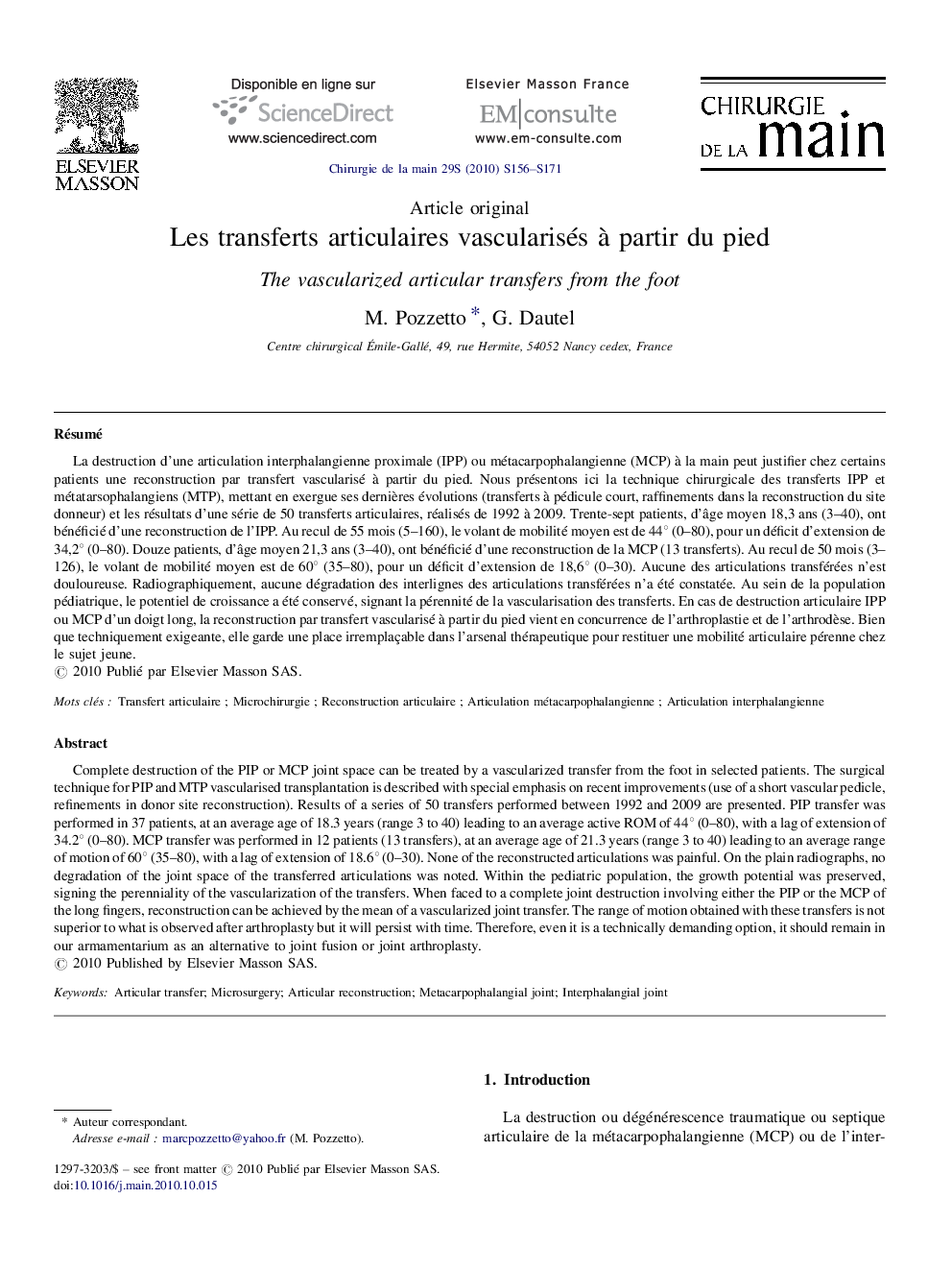| Article ID | Journal | Published Year | Pages | File Type |
|---|---|---|---|---|
| 4049607 | Chirurgie de la Main | 2010 | 16 Pages |
RésuméLa destruction d’une articulation interphalangienne proximale (IPP) ou métacarpophalangienne (MCP) à la main peut justifier chez certains patients une reconstruction par transfert vascularisé à partir du pied. Nous présentons ici la technique chirurgicale des transferts IPP et métatarsophalangiens (MTP), mettant en exergue ses dernières évolutions (transferts à pédicule court, raffinements dans la reconstruction du site donneur) et les résultats d’une série de 50 transferts articulaires, réalisés de 1992 à 2009. Trente-sept patients, d’âge moyen 18,3 ans (3–40), ont bénéficié d’une reconstruction de l’IPP. Au recul de 55 mois (5–160), le volant de mobilité moyen est de 44° (0–80), pour un déficit d’extension de 34,2° (0–80). Douze patients, d’âge moyen 21,3 ans (3–40), ont bénéficié d’une reconstruction de la MCP (13 transferts). Au recul de 50 mois (3–126), le volant de mobilité moyen est de 60° (35–80), pour un déficit d’extension de 18,6° (0–30). Aucune des articulations transférées n’est douloureuse. Radiographiquement, aucune dégradation des interlignes des articulations transférées n’a été constatée. Au sein de la population pédiatrique, le potentiel de croissance a été conservé, signant la pérennité de la vascularisation des transferts. En cas de destruction articulaire IPP ou MCP d’un doigt long, la reconstruction par transfert vascularisé à partir du pied vient en concurrence de l’arthroplastie et de l’arthrodèse. Bien que techniquement exigeante, elle garde une place irremplaçable dans l’arsenal thérapeutique pour restituer une mobilité articulaire pérenne chez le sujet jeune.
Complete destruction of the PIP or MCP joint space can be treated by a vascularized transfer from the foot in selected patients. The surgical technique for PIP and MTP vascularised transplantation is described with special emphasis on recent improvements (use of a short vascular pedicle, refinements in donor site reconstruction). Results of a series of 50 transfers performed between 1992 and 2009 are presented. PIP transfer was performed in 37 patients, at an average age of 18.3 years (range 3 to 40) leading to an average active ROM of 44° (0–80), with a lag of extension of 34.2° (0–80). MCP transfer was performed in 12 patients (13 transfers), at an average age of 21.3 years (range 3 to 40) leading to an average range of motion of 60° (35–80), with a lag of extension of 18.6° (0–30). None of the reconstructed articulations was painful. On the plain radiographs, no degradation of the joint space of the transferred articulations was noted. Within the pediatric population, the growth potential was preserved, signing the perenniality of the vascularization of the transfers. When faced to a complete joint destruction involving either the PIP or the MCP of the long fingers, reconstruction can be achieved by the mean of a vascularized joint transfer. The range of motion obtained with these transfers is not superior to what is observed after arthroplasty but it will persist with time. Therefore, even it is a technically demanding option, it should remain in our armamentarium as an alternative to joint fusion or joint arthroplasty.
